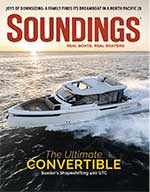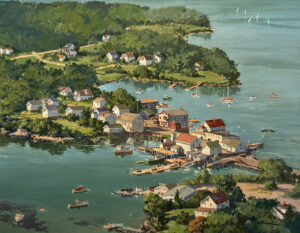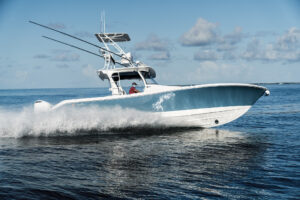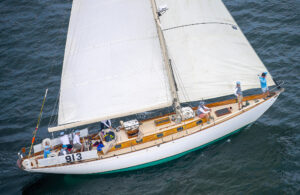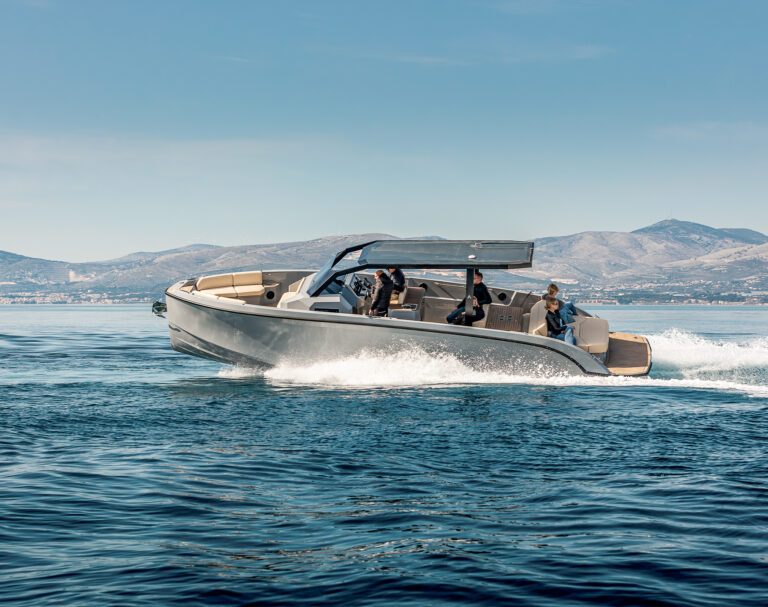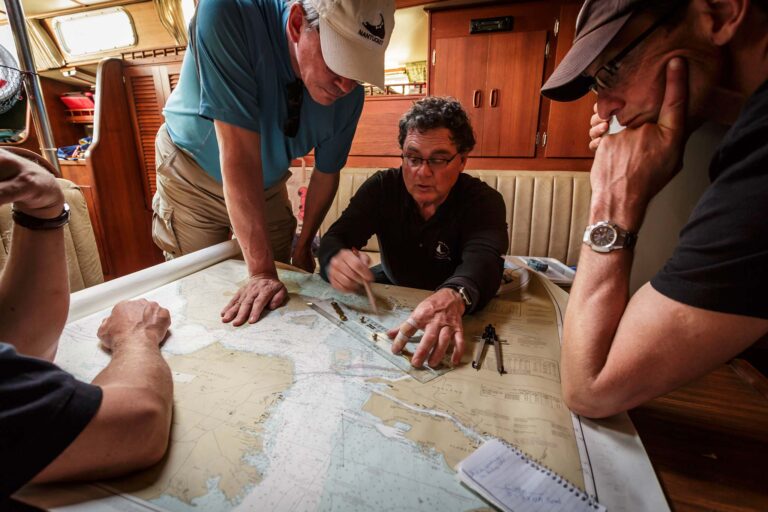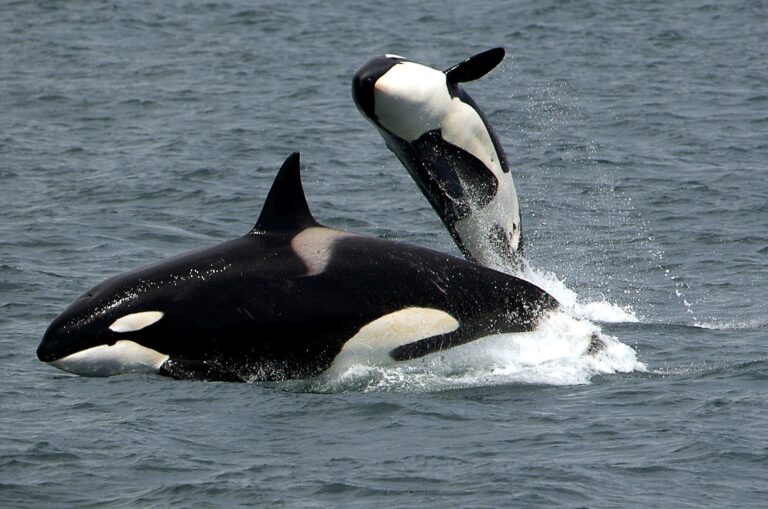Anyone who has been around boats for more than a couple of years knows the work of Mark Ellis. A native of Upstate New York, Ellis discovered a fondness for the water as a youngster summering on the St. Lawrence River. That early interest led him to a distinguished career as a yacht designer. He worked at major firms in the U.S. alongside giants in the industry before starting his own company in Canada at the age of 30. In the decades that followed, he produced a broad range of work, from custom builds to production sail and powerboats. Ellis—who is now retired from designing and living in Connecticut—recently announced that Mystic Seaport Museum will add his portfolio to its Ships Plans Library. We caught up with him briefly to learn more about that, and to just talk boats.

SOUNDINGS: The Ships Plans Library at Mystic Seaport Museum is an impressive collection featuring works by the top boat designers of all time. How does it feel to have your work preserved there?
MARK ELLIS: I’m extremely happy the museum will be a home for my designs. I’m a known designer, but it’s not like I’m Philip Rhodes or Ray Hunt. Well, not yet. In all honesty, I’ve got a good enough ego, and I’m so pleased to be in their company. I’ve had a good career. It amazes me that I’m at this point, being recognized at age 77.
SO: If you were sending a friend to the library to see your work, which design would you suggest they see?
ME: My favorite boat of all time is Volunteer. From my standpoint, it’s the best of the bunch. A 47-foot day sloop built in 1996, it was commissioned by Fred Eaton, who I met at the Royal Canadian Yacht Club. He was the great grandson of the founder of Eaton’s department store and his family was like Canadian aristocracy. We became very good friends. He wanted a boat with style from a bygone era that was long and lean, only with a modern underbody. Volunteer was designed to be what people today call Spirit of Tradition. The idea was to make it an elegant boat and it was.
SO: Where is that boat today?
ME: It’s out in Southern California, still sailing.
SO: You grew up in Upstate New York and summered in the Thousand Islands. How did time spent there influence your work?
ME: I grew up during a period when boats were still fairly traditional. In the 1950s and ’60s the production boat business was quite small.There were sailboats from Sparkman & Stephens. Powerboats were by Chris-Craft, Gar Wood and Century. I grew up around a lot of wooden boats and they influenced my outlook. My interest in boats really picked up when the 12 Metre class came to the America’s Cup in the late 1950s. Around that time, my father died. I was 13. I was able to sink my feelings into the boat stuff.
SO: As a young man, you were comfortable in both sailboats and powerboats. Is that right?
ME: Yes. After the war we had a Chris-Craft, ancient Peterborough canoes, a Lightning. My father had an Atkin yawl designed and built. We had all of it. Sailing was more my identity than power, but I was certainly involved in both. I just gave the Connecticut River Museum a Frostbite that I sailed when I was 11, an original built in the 1930s.
SO: How did your career as a boat designer begin?
ME: As a young man, I spent hours teaching myself how to draw boats. In high school, I had to choose a “Career Book” about a profession I wanted to pursue. The only book available on the subject was Elements of Yacht Design by Norman Skene.
I didn’t go to naval architecture school because it focused on large ship design and my love was smaller boats. Instead, I got a degree in business at Boston University. It gave me an advantage as a yacht designer because I knew how to run a business and design boats. While I was an undergraduate, I worked as a draftsman at C. Raymond Hunt
Associates in New Bedford. I was self-taught and they needed a body. John Deknatel hired me. He was a wonderful guy. Multifaceted. Harvard grad. He was one of a great gang. My whole world was over at that office, with these guys who were 10 years older than I was. I’m thankful they brought me into their society.
SO: What did you do after college?
ME: I went to work for Philip Rhodes in New York City, where I supervised the construction of large ketches. Then I was hired by Ted Hood at Little Harbor Yachts in Marblehead as a draftsman/designer, developing plans for the centerboard boats Hood was having built at the Frans Maas yard in the Netherlands. I learned a lot. I used to race on Sundays with Ted on his 52- foot Robin. Racing was a big part of what I did at that time, as navigator. Later, in 1970, I took a job with C&C in Canada, working largely on custom ocean racers.

SO: In 1975, you started Mark Ellis Design Ltd. Your first commission was the Aurora 40. Later came the Niagara 35. But the boat that really put you on the map was the Nonsuch 30.
ME: That boat was the brainchild of Canadian yachtsman Gordon Fisher, a friend who had co-skippered Manitou in her winning of the Canada Cup. He wanted to do a fin-keel, spade-rudder catboat, because he was tired of big boat racing and all that went with it. He wanted a simple boat that could be raced singlehanded or perhaps by two people. And he didn’t want a boom. He wanted a wishbone. He offered to put up the money for the tooling and said he was good for the first four hulls. With that commitment, I was able to get George Hinterhoeller to build the boat.
SO: Would you call the Nonsuch 30 your most successful design?
ME: Yes, in terms of volume. There were about 550 constructed. The 30 was the first in what became the Nonsuch series, of which more than 1,000 were built. It just took off.
SO: It must please you to know some of your early designs are still in production: Limestone Boats, for instance, a brand that was recently re-introduced into the marketplace. Where did the original design come from?
ME: So, Fred Eaton came to the opening of the Royal Canadian Yacht Club every spring. One year, I took him out on Georgian Bay aboard my Nonsuch. He had just sold his Bertram 25, which he loved, and he said, ‘I’m looking for something a little smaller. A utility.’ He wanted something with a good, safe bottom that he could use to go back and forth to his cottage. So I said, I can do that.
The following Monday, Fred called me and said he was serious about the boat, that it wasn’t just the drink talking. I said the same was true for me. The first Limestone was a 24 built in 1985. For a utility, it was very cool. I coined the name for the boat because there’s plenty of limestone around Georgian Bay. It didn’t go over well with Mrs. Eaton, though. She thought it was crazy to name a boat after a stone.
SO: If you were to design one more boat today, what would you want to work on?
ME: I’d like to do another another Spirit of Tradition sailboat. Or something along the lines of my Bruckmann 50, which is so pretty. I like boats with classic lines that don’t fall out of style. There seem to be a lot of ugly boats out there. We don’t have to be ugly.
SO: Is there a designer currently working whose boats you admire?
ME: I think Doug Zurn is doing great work. And Bob Perry is another one. But you know, you don’t hear a lot about boat designers anymore, not in the same way you did years ago, when people like Bruce Farr were being written and talked about.

SO: Why is that, in your opinion?
ME: I think It’s because of computers. Back when boats were hand-drawn, designers needed a strong intuitive sense. It took real stuff. Today, the shape-development programs are so good, more people are better at it, and so the personalities don’t stand out as much.
SO: If you were just starting out in the marine business today, what type of work would you do?
ME: I’d still want to do sailboats, as a designer.
SO: Do you have a favorite sailing partner?
ME: Jim Eastland, who I got to know in the 1970s. We got along well and saw things the same way. And he was a really good sailor with great knowledge of what’s happening around him.
SO: Where is your favorite place to sail?
ME: There are a lot of great harbors out there, although so many are just too crowded these days. But my favorite location is Buzzards Bay. When an afternoon smokey sou’wester comes up, there’s no place like it.
This article was originally published in the January 2023 issue.

